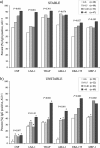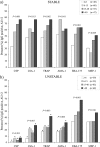Low prevalence of antibodies to preerythrocytic but not blood-stage Plasmodium falciparum antigens in an area of unstable malaria transmission compared to prevalence in an area of stable malaria transmission
- PMID: 18809666
- PMCID: PMC2583556
- DOI: 10.1128/IAI.00591-08
Low prevalence of antibodies to preerythrocytic but not blood-stage Plasmodium falciparum antigens in an area of unstable malaria transmission compared to prevalence in an area of stable malaria transmission
Abstract
In areas where levels of transmission of Plasmodium falciparum are high and stable, the age-related acquisition of high-level immunoglobulin G (IgG) antibodies to preerythrocytic circumsporozoite protein (CSP) and liver-stage antigen 1 (LSA-1) has been associated with protection from clinical malaria. In contrast, age-related protection from malaria develops slowly or not at all in residents of epidemic-prone areas with unstable low levels of malaria transmission. We hypothesized that this suboptimal clinical and parasitological immunity may in part be due to reduced antibodies to CSP or LSA-1 and/or vaccine candidate blood-stage antigens. Frequencies and levels of IgG antibodies to CSP, LSA-1, thrombospondin-related adhesive protein (TRAP), apical membrane antigen 1 (AMA-1), erythrocyte binding antigen 175 (EBA-175), and merozoite surface protein 1 (MSP-1) were compared in 243 Kenyans living in a highland area of unstable transmission and 210 residents of a nearby lowland area of stable transmission. Levels of antibodies to CSP, LSA-1, TRAP, and AMA-1 in the oldest age group (>40 years) in the unstable transmission area were lower than or similar to those of children 2 to 6 years old in the stable transmission area. Only 3.3% of individuals in the unstable transmission area had high levels of IgG (>2 arbitrary units) to both CSP and LSA-1, compared to 43.3% of individuals in the stable transmission area. In contrast, antibody levels to and frequencies of MSP-1 and EBA-175 were similar in adults in areas of stable and unstable malaria transmission. Suboptimal immunity to malaria in areas of unstable malaria transmission may relate in part to infrequent high-level antibodies to preerythrocytic antigens and AMA-1.
Figures


Similar articles
-
Effect of transmission intensity and age on subclass antibody responses to Plasmodium falciparum pre-erythrocytic and blood-stage antigens.Acta Trop. 2015 Feb;142:47-56. doi: 10.1016/j.actatropica.2014.10.011. Epub 2014 Oct 24. Acta Trop. 2015. PMID: 25446174 Free PMC article.
-
Correlation of high levels of antibodies to multiple pre-erythrocytic Plasmodium falciparum antigens and protection from infection.Am J Trop Med Hyg. 2005 Jul;73(1):222-8. Am J Trop Med Hyg. 2005. PMID: 16014863
-
Antibodies to the Plasmodium falciparum antigens circumsporozoite protein, thrombospondin-related adhesive protein, and liver-stage antigen 1 vary by ages of subjects and by season in a highland area of Kenya.Infect Immun. 2003 Aug;71(8):4320-5. doi: 10.1128/IAI.71.8.4320-4325.2003. Infect Immun. 2003. PMID: 12874308 Free PMC article.
-
Antibody Correlates of Protection from Clinical Plasmodium falciparum Malaria in an Area of Low and Unstable Malaria Transmission.Am J Trop Med Hyg. 2020 Dec;103(6):2174-2182. doi: 10.4269/ajtmh.18-0805. Epub 2020 Oct 27. Am J Trop Med Hyg. 2020. PMID: 33124533 Free PMC article. Review.
-
Situation analysis of malaria in school-aged children in Kenya - what can be done?Parasitol Today. 2000 May;16(5):183-6. doi: 10.1016/s0169-4758(00)01663-x. Parasitol Today. 2000. PMID: 10782073 Review. No abstract available.
Cited by
-
Antibody Profiles to P. falciparum Antigens Over Time Characterize Acute and Long-Term Malaria Exposure in an Area of Low and Unstable Transmission.Am J Trop Med Hyg. 2020 Dec;103(6):2189-2197. doi: 10.4269/ajtmh.19-0480. Epub 2020 Oct 27. Am J Trop Med Hyg. 2020. PMID: 33124539 Free PMC article.
-
Estimation of recent and long-term malaria transmission in a population by antibody testing to multiple Plasmodium falciparum antigens.J Infect Dis. 2014 Oct 1;210(7):1123-32. doi: 10.1093/infdis/jiu225. Epub 2014 Apr 15. J Infect Dis. 2014. PMID: 24737801 Free PMC article.
-
Host genetic polymorphisms and serological response against malaria in a selected population in Sri Lanka.Malar J. 2018 Dec 17;17(1):473. doi: 10.1186/s12936-018-2622-9. Malar J. 2018. PMID: 30558622 Free PMC article.
-
Research priorities for the development and implementation of serological tools for malaria surveillance.F1000Prime Rep. 2014 Nov 4;6:100. doi: 10.12703/P6-100. eCollection 2014. F1000Prime Rep. 2014. PMID: 25580254 Free PMC article. Review.
-
Surveillance of vector populations and malaria transmission during the 2009/10 El Niño event in the western Kenya highlands: opportunities for early detection of malaria hyper-transmission.Parasit Vectors. 2011 Jul 22;4:144. doi: 10.1186/1756-3305-4-144. Parasit Vectors. 2011. PMID: 21781291 Free PMC article.
References
-
- Alonso, P. L., J. Sacarlal, J. J. Aponte, A. Leach, E. Macete, P. Aide, B. Sigauque, J. Milman, I. Mandomando, Q. Bassat, C. Guinovart, M. Espasa, S. Corachan, M. Lievens, M. M. Navia, M. C. Dubois, C. Menendez, F. Dubovsky, J. Cohen, R. Thompson, and W. R. Ballou. 2005. Duration of protection with RTS,S/AS02A malaria vaccine in prevention of Plasmodium falciparum disease in Mozambican children: single-blind extended follow-up of a randomised controlled trial. Lancet 3662012-2018. - PubMed
-
- al-Yaman, F., B. Genton, R. F. Anders, M. Falk, T. Triglia, D. Lewis, J. Hii, H. P. Beck, and M. P. Alpers. 1994. Relationship between humoral response to Plasmodium falciparum merozoite surface antigen-2 and malaria morbidity in a highly endemic area of Papua New Guinea. Am. J. Trop. Med. Hyg. 51593-602. - PubMed
-
- Beier, J. C., P. V. Perkins, F. K. Onyango, T. P. Gargan, C. N. Oster, R. E. Whitmire, D. K. Koech, and C. R. Roberts. 1990. Characterization of malaria transmission by Anopheles (Diptera: Culicidae) in western Kenya in preparation for malaria vaccine trials. J. Med. Entomol. 27570-577. - PubMed
-
- Bojang, K. A., P. J. Milligan, M. Pinder, L. Vigneron, A. Alloueche, K. E. Kester, W. R. Ballou, D. J. Conway, W. H. Reece, P. Gothard, L. Yamuah, M. Delchambre, G. Voss, B. M. Greenwood, A. Hill, K. P. McAdam, N. Tornieporth, J. D. Cohen, and T. Doherty. 2001. Efficacy of RTS,S/AS02 malaria vaccine against Plasmodium falciparum infection in semi-immune adult men in The Gambia: a randomised trial. Lancet 3581927-1934. - PubMed
-
- Branch, O. H., V. Udhayakumar, A. W. Hightower, A. J. Oloo, W. A. Hawley, B. L. Nahlen, P. B. Bloland, D. C. Kaslow, and A. A. Lal. 1998. A longitudinal investigation of IgG and IgM antibody responses to the merozoite surface protein-1 19-kiloDalton domain of Plasmodium falciparum in pregnant women and infants: associations with febrile illness, parasitemia, and anemia. Am. J. Trop. Med. Hyg. 58211-219. - PubMed
Publication types
MeSH terms
Substances
Grants and funding
LinkOut - more resources
Full Text Sources
Research Materials

